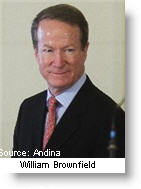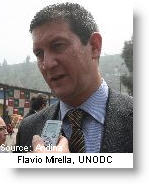 Budgetary constraints are leading the U.S. government to seek other nations with which to share the cost of supporting Peru’s counter-narcotics program, according to U.S. Ambassador Rose Likins during the CADE 2011 business conference in Cusco on Thursday.
Budgetary constraints are leading the U.S. government to seek other nations with which to share the cost of supporting Peru’s counter-narcotics program, according to U.S. Ambassador Rose Likins during the CADE 2011 business conference in Cusco on Thursday.
Likins’ announcement follows statements made earlier this week in Lima by William Brownfield, U.S. assistant secretary of state for the Bureau of International Narcotics and Law Enforcement Affairs.
Flavio Mirella, representative in Peru for the United Nations Office on Drugs and Crime, UNODC, believes the U.S. should provide more resources to Peru’s anti-narcotics efforts but said that Brownfield’s message was a “good sign.”
The U.S. was initially critical of President Humala’s appointment of Ricardo Soberon to head the counter-drugs agency Devida, and of his proposals for the country’s 2012-2016 anti-drug plan. Soberon, a lawyer and specialist with 30 years experience in narcotics policies, coca production and the Amazon basin, believes forced coca eradication is not effective if strong education and alternative crop programs are not in place.
During a press conference at the government palace in Lima, Brownfield said, “Peru has a sovereign right to decide its strategy. It has consulted with us and the United States is going to support Peru’s national anti-drug strategy.”
 “We are talking about concrete messages of support for the anti-drug policy and a line of shared responsibility,” Mirella said. “I think it is an excellent signal.”
“We are talking about concrete messages of support for the anti-drug policy and a line of shared responsibility,” Mirella said. “I think it is an excellent signal.”
Mirella also considered the timing of Brownfield’s visit was positive, shortly before the Humala administration is to present its national strategy to combat drug trafficking and money laundering.
However, Brownfield emphasized that although Peru is an important part of the U.S. narcotics policy, current U.S. political, economic and budgetary realities have to be accepted.
Peru and the U.S. “undoubtedly” need to organize their strategies to be effective, he said —“that is why I am here, to see how we can best organize our efforts to make sure our mutual resources have the greatest impact and are most effective.”
But he also stressed that other nations in North and South America as well as Asia and Europe need to join in the efforts. The anti-narcotics strategies need new partners, he said, not only in terms of getting together in conferences and meetings but also in assigning resources.
Brownfield visited President Humala with the US ambassador to Peru, Rose Likins; Peru’s ambassador to Washington, Harold Forsyth; Cabinet chief Salomon Lerher Ghitis, and the executive president of Devida, Ricardo Soberon.
The U.S. Drug Enforcement Administration said in October that it now estimates Peru is the world’s biggest cocaine producer, overtaking Colombia.
Cocaine production in Peru has seen an increase in recent years, as output is shifted to the Andean nation from Colombia, where U.S.-supported programs have decreased output.
The world’s other major producer of cocaine is Bolivia.





